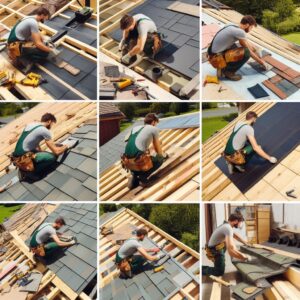 DIY roofing is not for the faint-hearted. The task demands not only technical knowledge but also accuracy, persistence and a great deal of caution. After all, the roof is not only a significant part of the house structure, but it also shields the home from the elements. One error could lead to disastrous consequences such as leaks, compromised building structure, or even personal injury.
DIY roofing is not for the faint-hearted. The task demands not only technical knowledge but also accuracy, persistence and a great deal of caution. After all, the roof is not only a significant part of the house structure, but it also shields the home from the elements. One error could lead to disastrous consequences such as leaks, compromised building structure, or even personal injury.
The first phase of any DIY roofing job is a thorough examination of the roof’s current condition. This assessment helps to determine which part of the roof needs repairs or replacement. Inspecting the roof for any signs of wear and tear, such as broken or missing shingles, will guide the decision-making process on whether to repair or replace.
Upon determining the needs of the roof, the next step includes choosing the appropriate materials and tools. The selection is guided by factors such as the roof’s current condition, the type of existing roof, local building regulations, and personal preference. Different materials offer various advantages, such as resistance to specific elements, aesthetic appeal, and lifespan. The tools required are dependent on the chosen material and the nature of the task – from simple tools like hammers and nails to more specialized ones like roofing nailers.
Safety equipment also forms a significant part of the preparation stage. DIY roofing invariably involves a certain level of risk; hence, investing in safety gear, such as sturdy boots, safety ropes and harnesses, can be life-saving.
Once all materials and tools are in place, the actual task of repairing or installing the roof begins. It’s important to have a systematic plan, which involves eliminating any existing damage, installing or repairing as necessary, and ensuring all parts are securely fastened. Without a strict order of operations, errors may occur, leading to a disappointing end result.
On completion of the roofing task, an essential step lies in checking the longevity of the job. This means that the work needs to stand the test of time, so constant maintenance and checks are unavoidable. Over time, weather changes can lead to wear and tear. Regular checks will help to detect and quickly address any potential issues, thereby extending the lifespan of the roof.
The act of DIY roofing might seem intimidating at first but with enough planning, preparation, and careful execution, the task is achievable. Nevertheless, remember: safety is always paramount.
Common Missteps in DIY Roofing
Mistakes and errors in do-it-yourself roofing are often common, given the complexity of the process. Key to this blunder is the lack of attention to urgent safety precautions. Emphasize the importance of security measures cannot be underestimated in such a risky engagement. Frail ladders, absence of roof anchors, safety belts, and no-slip footwear should never be an option. Safety oversights can result in critical injuries due to the potential instability and high altitude involved.
Another major error lies in the improper installation of shingles. Shingles are critical protective elements against harsh weather conditions; hence their incorrect installation can be significant. It could lead to water infiltration and consequent extensive damage. Specific roofing materials require distinct installation protocols that should be followed religiously.
Equally important to note is the often-overlooked aspect of adequate ventilation. An appropriately ventilated roof is vital in managing temperature in the roofing system. Moreover, it hinders the accumulation of moisture that triggers the growth of mold and speeds up rotting, hence vital for the overall durability of the roofing structure.
Weather conditions are another frequently overlooked factor when undertaking roofing projects. It’s advisable always to carry out such tasks in clear and calm weather. Adverse weather not only poses difficulty in the execution but also poses a significant threat to the quality of, effective planning, and meticulous execution when undertaking a DIY roofing project.
Successful DIY Roofing

Taking the reigns of any do-it-yourself project can be intimidating, particularly in the case of roofing, one of the most significant elements of a home. Providing timely protection, a well-maintained roof not only fortifies the exterior of your property but can also influence interior comfort levels too. In order to successfully manage DIY roofing, it’s vital to circumnavigate common pitfalls.
Knowledge becomes your greatest asset; comprehensive research about the materials needed dovetails with an understanding of your roof’s specific nature. Perhaps it’s pitched or flat, large or small, each type of roof requires different tools, techniques, and types of shingles. significant problems, this proactive approach can ward off large-scale repairs.
Negotiating the path of a DIY roofing project doesn’t have to be an uphill battle. Armed with the correct knowledge, meticulous preparation, and strict attention to detail, it’s possible to efficiently and safely install or repair a roof. Although it may initially seem daunting, the satisfaction and fiscal savings stemming from a job well done will surely outweigh any preliminary apprehensions.
Each successful DIY roofing project denotes more than a well-executed task; it denotes the homeowner’s independence and commitment to home maintenance; a skillset that is both valuable and admirable.